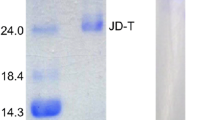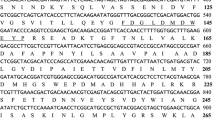Abstract
Complementary DNA clones encoding trypsins were isolated from pyloric ceca of cold-adapted fish, walleye pollock (Theragra chalcogramma) (WP-T) and Arctic cod (Boreogadus saida) (AC-T). The isolated full-length cDNA clones of WP-T and AC-T were 852 and 860 bp, respectively, and both cDNAs were contained an open reading frame of 726 bp. WP-T and AC-T seemed to be synthesized as preproenzyme that contains a signal peptide, an activation peptide, and a mature trypsin. Although the amino acid sequence identities of WP-T and AC-T to that of bovine trypsin were 64 and 63%, respectively, they completely conserved the structural features for catalytic function of trypsin. On the other hand, WP-T and AC-T possessed the four Met residues (Met135, Met145, Met175 and Met242) in their molecules and the deletion of Tyr151 and substitution of Pro152 for Gly in their autolysis loops when aligned with the sequences of tropical-zone fish and bovine trypsins. In addition, the contents of charged amino acid residues at the N-terminal regions (positions 20–50) of WP-T and AC-T were extremely higher than those of other fish and bovine trypsins. Moreover, one amino acid (Asn72) and two amino acids (Asn72 and Val75) coordinating with Ca2+ in bovine trypsin were exchanged for another amino acids in WP-T (His) and AC-T (His and Glu), respectively, and the contents of negative charged amino acids at their Ca2+-binding regions were lower than those of tropical-zone fish and bovine trypsins. Therefore, it was considered that these structural characteristics of WP-T and AC-T are closely related to their lower thermostability.





Similar content being viewed by others
References
Rypniewski WR, Perrakis A, Vorgias CE, Wilson KS (1994) Evolutionary divergence and conservation of trypsin. Protein Eng 7:57–64
Stroud RM, Kay LM, Dickerson RE (1974) The structure of bovine trypsin: electron density maps of the inhibited enzyme at 5 A and at 2.7 A resolution. J Mol Biol 83:185–208
Hedstrom L, Szilagyi L, Rutter WJ (1992) Converting trypsin to chymotrypsin: the role of surface roops. Science 255:1249–1253
Hedstrom L, Perona J, Rutter WJ (1994) Converting trypsin to chymotrypsin: residue 172 is a substrate specificity determinant. Biochemistry 33:8757–8763
Hedstrom L, Lin T, Fast W (1996) Hydrophobic interactions control zymogen activation in the trypsin family of serine proteases. Biochemistry 35:4515–4523
Pasternak A, Liu X, Lin T, Hedstrom L (1998) Activating a zymogen with out proteolytic processing: mutation of Lys15 and Asn194 activates trypsinogen. Biochemistry 37:16201–16210
Szabo E, Bocskei Z, Naray-Szabo G, Graf L (1999) The three-dimensional structure of Asp189Ser trypsin provides evidence for an inherent structural plasticity of the proteases. Eur J Biochem 263:20–26
Hjelmeland K, Raa J (1982) Characteristics of two trypsin type isozymes isolated from the Arctic fish capelin (Mallotus villosus). Comp Biochem Physiol 71B:557–562
Simpson BK, Haard NF (1984) Trypsin from Greenland cod, Gadus ogac. Isolation and comparative properties. Comp Biochem Physiol 79B:613–622
Asgeirsson B, Fox JW, Bjarnason JB (1989) Purification and characterization of trypsin from the poikilotherm Gadus morhua. Eur J Biochem 180:85–94
Kristjansson MM (1991) Purification and characterization of trypsin from the pyloric caeca of rainbow trout (Oncorhynchus mykiss). J Agric Food Chem 39:1738–1742
Outzen H, Berglund GI, Smalas AO, Willassen NP (1996) Temperature and pH sensitivity of trypsins from Atlantic salmon (Salmo salar) in comparison with bovine and porcine trypsin. Comp Biochem Physiol 115B:33–45
Simpson BK, Haard NF (1987) Cold-adapted enzymes from fish. In: Knorr D (ed) Food biotechnology. Marcel Dekker, New York, pp 495–528
Bjarnason JB (2000) Fish serine proteases and their pharmaceutical and cosmetic use. Patent PCT, WO 00/78332 A2, 28 Dec 2000
Bjarnason JB, Benediktsson B (2001) Protein hydrolysates produced with the use of marine proteases. Patent PCT, WO 01/28353 A2, 26 Apr 2001
Kishimura H, Hayashi K, Miyashita Y, Nonami Y (2005) Characteristics of two trypsin isozymes from the viscera of Japanese anchovy (Engraulis japonica). J Food Biochem 29:459–469
Kishimura H, Hayashi K, Miyashita Y, Nonami Y (2006) Characteristics of trypsins from the viscera of true sardine (Sardinops melanostictus) and the pyloric ceca of arabesque greenling (Pleuroprammus azonus). Food Chem 97:65–70
Kishimura H, Tokuda Y, Klomklao S, Benjakul S, Ando S (2006) Enzymatic characteristics of trypsin from the pyloric ceca of spotted mackerel (Scomber australasicus). J Food Biochem 30:466–477
Kishimura H, Tokuda Y, Klomklao S, Benjakul S, Ando S (2006) Comparative study on enzymatic characteristics of trypsins from the pyloric ceca of yellow tail (Seriola quinqueradiata) and brown hakeling (Physiculus japonicus). J Food Biochem 30:521–534
Kishimura H, Tokuda Y, Yabe M, Klomklao S, Benjakul S, Ando S (2007) Trypsins from the pyloric ceca of jacopever (Sebastes schlegeli) and elkhorn sculpin (Alcichthys alcicornis): isolation and characterization. Food Chem 100:1490–1495
Klomklao S, Benjakul S, Visessanguan W, Kishimura H, Simpson BK, Saeki H (2006) Trypsins from yellowfin tuna (Thunnus albacores) spleen: purification and characterization. Comp Biochem Physiol 144B:47–56
Klomklao S, Benjakul S, Visessanguan W, Kishimura H, Simpson BK (2006) Purification and characterization of trypsin from spleen of tongol tuna (Thunnus tonggol). J Agric Food Chem 54:5617–5622
Klomklao S, Benjakul S, Visessanguan W, Kishimura H, Simpson BK (2007) Purification and characterization of trypsins from skipjack tuna (Katsuwonus pelamis) spleen. Food Chem 100:1580–1589
Klomklao S, Benjakul S, Visessanguan W, Kishimura H, Simpson BK (2007) Trypsin from the pyloric ceca of bluefish (Pomatomus saltatrix). Comp Biochem Physiol 148B:382–389
Klomklao S, Benjakul S, Visessanguan W, Kishimura H, Simpson BK (2007) A 29 kDa protease from the digestive glands of Atlantic bonito (Sarda sarda): recovery and characterization. J Agric Food Chem 55:4548–4553
Kishimura H, Klomklao S, Benjakul S, Chun B-S (2008) Characteristics of trypsin from the pyloric ceca of walleye pollock (Theragra chalcogramma). Food Chem 106:194–199
Fuchise T, Kishimura H, Sekizaki H, Nonami Y, Kanno G, Klomklao S, Benjakul S, Chun B-S (2009) Purification and characteristics of cold-zone fish trypsin, Pacific cod (Gadus macrocephalus) and saffron cod (Eleginus gracilis). Food Chem 116:611–616
Kanno G, Kishimura H, Ando S, Nalinanon S, Klomklao S, Benjakul S, Chun B-S, Saeki H (2011) Structural properties of trypsin from cold-adapted fish, arabesque greenling (Pleurogrammus azonus). Eur Food Res Technol 232:381–388
Ahsan MN, Funabara D, Watabe S (2001) Molecular cloning and characterization of two isoforms of trypsinogen from anchovy pyloric ceca. Mar Biotechnol 3:80–90
Gudmundsdottir A, Gudmundsdottir E, Oskarsson S, Bjarnason JB, Eakin AK, Craik CS (1993) Isolation and characterization of cDNAs from Atlantic cod encoding two different forms of trypsinogen. Eur J Biochem 217:1091–1097
Genicot S, Rentier-Delrue F, Edwards D, Vanbeeumen J, Gerday C (1996) Trypsin and trypsinogen from Antarctic fish: molecular basis of cold adaptation. Biochim Biophys Acta 1298:45–57
Ruan G-L, Li Y, Gao Z-X, Wang H-L, Wang W-M (2010) Molecular characterization of trypsinogens and development of trypsinogen gene expression and tryptic activities in grass carp (Ctenopharyngodon idellus) and topmouth culter (Culter alburnus). Comp Biochem Physiol Part B 155:77–85
Watson MEE (1984) Compilation of published signal sequences. Nucleic Acids Res 12:5145–5164
Louvard MN, Puigserver A (1974) On bovine and porcine anionic trypsinogens. Biochim Biophys Acta 371:177–185
Huerou IL, Wicker C, Guilloteau P, Toullec R, Puigserver A (1990) Isolation and nucleotide sequence of cDNA clone for bovine pancreatic anionic trypsinogen: structural identity within the trypsin family. Eur J Biochem 193:767–773
Krem MM, Rose T, Cera ED (1999) The C-terminal sequence encodes function in serine proteases. J Biol Chem 274:28063–28066
Leiros H-KS, Willassen NP, Smalas AO (2000) Structural comparison of psychrophilic and mesophilic trypsins: elucidating the molecular basis of cold-adaptation. Eur J Biochem 267:1039–1049
Gable D, Kasche V (1973) Autolysis of β-trypsin: influences of calcium ions and heat. Acta Chem Scand 27:1971–1981
Kanno G, Yamaguchi T, Kishimura H, Yamaha E, Saeki H (2010) Purification and characteristics of trypsin from masu salmon (Oncorhynchus masou) cultured in fresh-water. Fish Physiol Biochem 36:637–645
Walsh KA (1970) Trypsinogens and trypsins of various species. Methods Enzymol 19:41–63
Bode W, Schwager P (1975) The single calcium-binding site of crystalline β-trypsin. FEBS Lett 56:139–143
Male R, Lorens LB, Smalas AO, Torrissen KR (1995) Molecular cloning and characterization of anionic and cationic variants of trypsin from Atlantic salmon. Eur J Biochem 232:677–685
Hartley BS, Kauffman DL (1966) Corrections to the amino acid sequence of bovine chymotrypsinogen A. Biochem J 101:229–231
Acknowledgments
We would like to thank crew and officers of the T/S Oshoro Maru, Hokkaido University, for in collecting Arctic cod. This research was partly supported by the grant from HOKUSUI Association.
Author information
Authors and Affiliations
Corresponding author
Rights and permissions
About this article
Cite this article
Kanno, G., Kishimura, H., Yamamoto, J. et al. Cold-adapted structural properties of trypsins from walleye pollock (Theragra chalcogramma) and Arctic cod (Boreogadus saida). Eur Food Res Technol 233, 963–972 (2011). https://doi.org/10.1007/s00217-011-1592-8
Received:
Revised:
Accepted:
Published:
Issue Date:
DOI: https://doi.org/10.1007/s00217-011-1592-8




